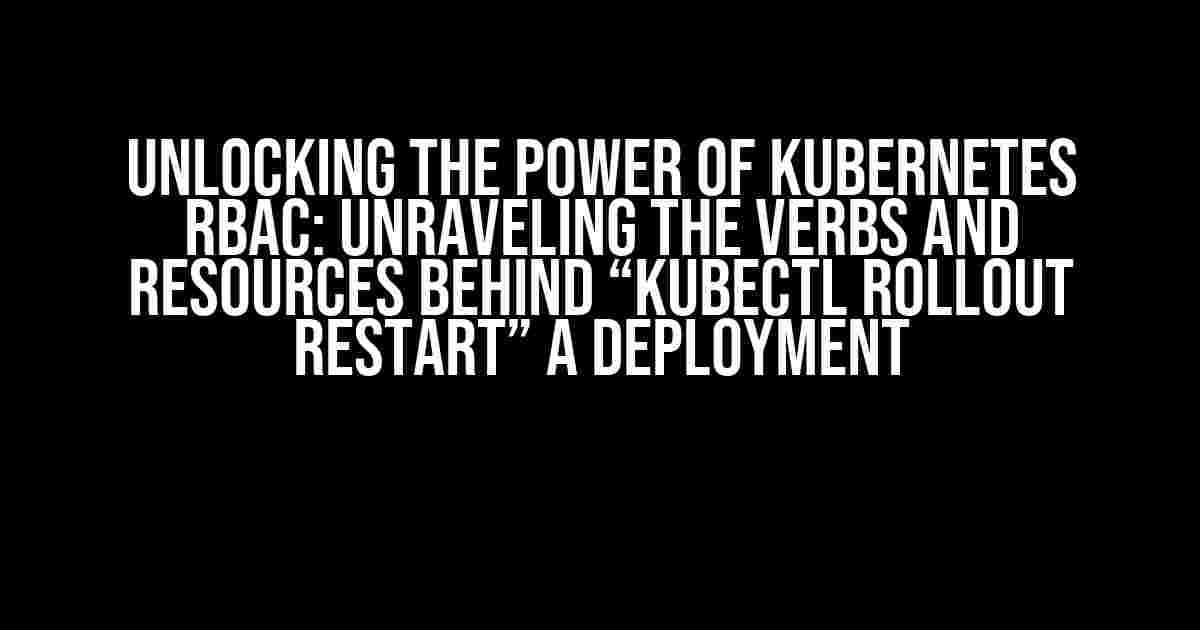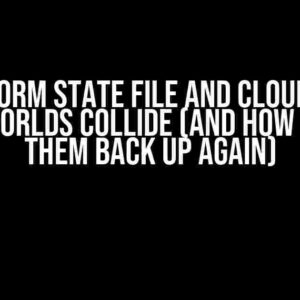In the realm of Kubernetes, Role-Based Access Control (RBAC) is the gatekeeper that governs access to critical cluster resources. As a developer or DevOps engineer, you’ve likely encountered the “kubectl rollout restart” command, but do you know the intricate dance of verbs and resources that makes it possible? In this article, we’ll delve into the world of Kubernetes RBAC, exploring the specific permissions required to restart a deployment using the “kubectl rollout restart” command.
The Kubernetes RBAC Basics
Before we dive into the nitty-gritty, let’s establish a solid foundation in Kubernetes RBAC. In a Kubernetes cluster, RBAC is a mechanism that assigns permissions to users or service accounts based on roles. These roles are composed of verbs and resources, which define the actions that can be performed on specific objects.
Verbs
In Kubernetes RBAC, verbs represent the actions that can be taken on resources. The most common verbs are:
get: Retrieves a resourcelist: Retrieves a list of resourcescreate: Creates a new resourceupdate: Updates an existing resourcedelete: Deletes a resourcepatch: Partially updates an existing resourcewatch: Watches for changes to a resource
Resources
Namespace-scoped resources: Resources that exist within a specific namespace, such as pods, services, and deployments.Cluster-scoped resources: Resources that exist at the cluster level, such as nodes, namespaces, and persistent volumes.
The “kubectl rollout restart” Command: Unraveling the Verbs and Resources
The “kubectl rollout restart” command is used to restart a deployment’s rollout process. But what exactly happens behind the scenes?
Verbs Involved
To execute the “kubectl rollout restart” command, the following verbs are required:
get: Retrieves the deployment objectupdate: Updates the deployment’s rollout statuscreate: Creates a new rollout revisionpatch: Partially updates the deployment’s rollout status
Resources Involved
The resources involved in the “kubectl rollout restart” command are:
deployments: The deployment object being restartedreplicasets: The replica sets associated with the deploymentpods: The pods created by the deployment
RBAC Configuration for “kubectl rollout restart”
To grant a user or service account permission to execute the “kubectl rollout restart” command, you’ll need to create a Role or ClusterRole that defines the required verbs and resources.
Role Example
Here’s an example Role that grants the necessary permissions:
apiVersion: rbac.authorization.k8s.io/v1 kind: Role metadata: name: deployment-restart-role rules: - apiGroups: - apps resources: - deployments verbs: - get - update - patch - apiGroups: - apps resources: - replicasets verbs: - get - update - patch - apiGroups: - "" resources: - pods verbs: - get - update - patch
ClusterRole Example
If you need to grant cluster-wide permissions, you can create a ClusterRole instead:
apiVersion: rbac.authorization.k8s.io/v1 kind: ClusterRole metadata: name: deployment-restart-clusterrole rules: - apiGroups: - apps resources: - deployments verbs: - get - update - patch - apiGroups: - apps resources: - replicasets verbs: - get - update - patch - apiGroups: - "" resources: - pods verbs: - get - update - patch
Binding the Role or ClusterRole
Once you’ve created the Role or ClusterRole, you’ll need to bind it to a user or service account using a RoleBinding or ClusterRoleBinding.
RoleBinding Example
Here’s an example RoleBinding that binds the Role to a user:
apiVersion: rbac.authorization.k8s.io/v1 kind: RoleBinding metadata: name: deployment-restart-rolebinding roleRef: name: deployment-restart-role kind: Role subjects: - kind: User name: jane apiGroup: rbac.authorization.k8s.io
ClusterRoleBinding Example
And here’s an example ClusterRoleBinding that binds the ClusterRole to a service account:
apiVersion: rbac.authorization.k8s.io/v1 kind: ClusterRoleBinding metadata: name: deployment-restart-clusterrolebinding roleRef: name: deployment-restart-clusterrole kind: ClusterRole subjects: - kind: ServiceAccount name: default namespace: default
Conclusion
In this article, we’ve navigated the complex world of Kubernetes RBAC, uncovering the verbs and resources required to execute the “kubectl rollout restart” command. By understanding the intricacies of RBAC, you can craft fine-grained permissions that grant users and service accounts the necessary access to perform critical cluster operations.
Additional Resources
For further learning, be sure to explore the following resources:
| Verb | Description |
|---|---|
get |
Retrieves a resource |
list |
Retrieves a list of resources |
create |
Creates a new resource |
update |
Updates an existing resource |
delete |
Deletes a resource |
patch |
Patch updates an existing resource |
watch |
Watches for changes to a resource |
This article has provided a comprehensive overview of the Kubernetes RBAC verbs and resources required for the “kubectl rollout restart” command. By mastering RBAC, you’ll be well-equipped to manage complex cluster permissions and ensure the security and integrity of your Kubernetes environment.
Frequently Asked Question
Get the inside scoop on Kubernetes RBAC verbs and resources that enable the “kubectl rollout restart” command for deployments!
What are the essential Kubernetes RBAC verbs required to execute “kubectl rollout restart” on a deployment?
To use the “kubectl rollout restart” command, you need to have the following Kubernetes RBAC verbs: “update” and “patch” on the deployment resource. These verbs allow you to modify the deployment and restart its rollout process.
Which Kubernetes resource is targeted by the “kubectl rollout restart” command?
The “kubectl rollout restart” command targets the Deployment resource. Specifically, it restarts the rollout process for the specified deployment.
Is it necessary to have “get” and “list” verbs on the Deployment resource to execute “kubectl rollout restart”?
Yes, having “get” and “list” verbs on the Deployment resource is necessary to execute “kubectl rollout restart”. These verbs allow you to retrieve the deployment’s current status and configuration, which is required to restart the rollout process.
Can I use “kubectl rollout restart” with other Kubernetes resources, such as ReplicaSets or Pods?
No, the “kubectl rollout restart” command is specifically designed for Deployments. It does not work with other resources like ReplicaSets or Pods.
How can I ensure I have the necessary permissions to execute “kubectl rollout restart” on a Deployment?
To ensure you have the necessary permissions, create a Role or ClusterRole that grants the required verbs (“update”, “patch”, “get”, and “list”) on the Deployment resource. Then, bind the Role or ClusterRole to a ServiceAccount or User using a RoleBinding or ClusterRoleBinding.


